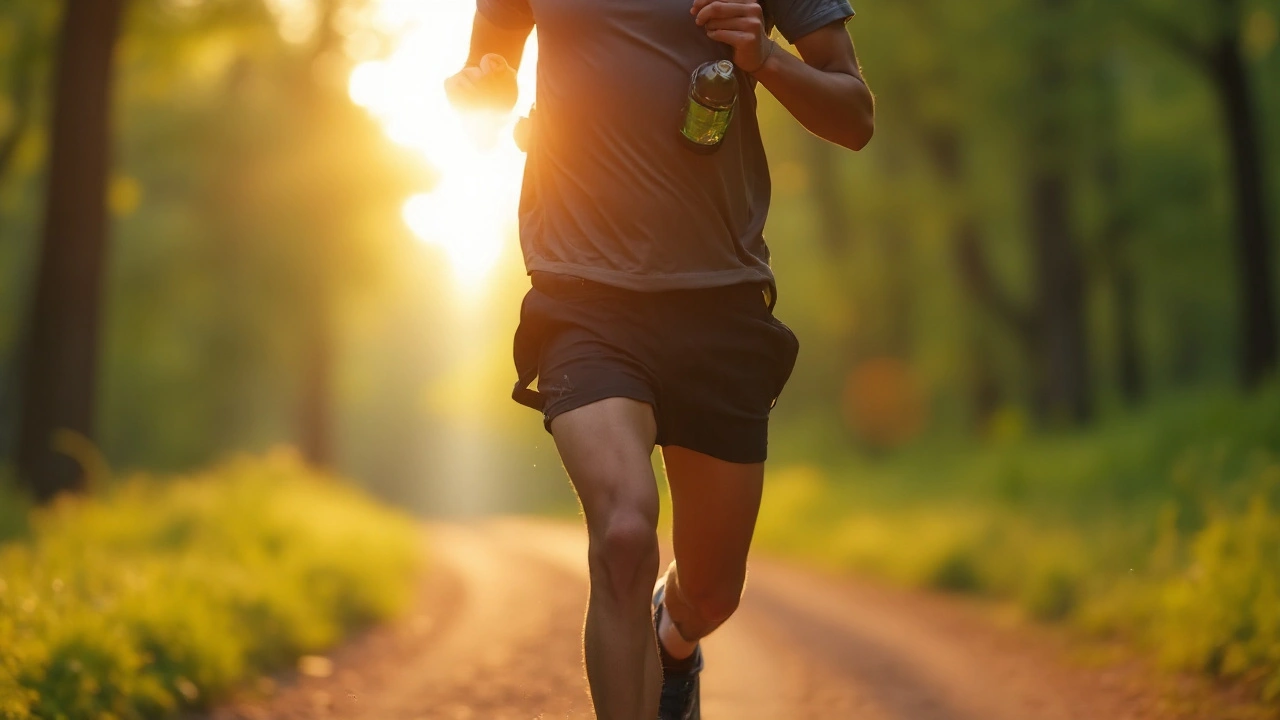Hydration is a physiological state where the body maintains optimal water levels in cells, tissues, and the outer skin layer. When water balance is right, skin stays pliable, sweat evaporates efficiently, and friction‑induced irritation drops dramatically.
Skin chafe is a painful irritation that occurs when friction repeatedly rubs the outer epidermis, breaking down the protective lipid film. Runners, cyclists, and hikers report chafe as a top complaint, often costing them hours of training.
Moisture barrier is a layer of lipids and natural moisturizing factors (NMF) that seals water inside the stratum corneum while keeping harmful agents out. A healthy barrier stops transepidermal water loss (TEWL) and resists abrasive forces.
Transepidermal water loss (TEWL) measures the amount of water vapor that escapes through the skin each hour. High TEWL readings correlate with dry, cracked skin that is more vulnerable to friction.
Friction is a mechanical force generated when two surfaces slide or press against each other. In the context of sports, friction often comes from clothing seams, shoes, or equipment straps.
Sportswear fabric is a technical textile engineered to manage sweat, reduce drag, and limit abrasive contact. Modern fabrics blend polyester, elastane, and moisture‑wicking fibers to keep skin dry.
Barrier cream is a topical product that forms a protective film over the skin, reducing shear forces while sealing in moisture. Common ingredients include dimethicone, zinc oxide, and petrolatum.
Why Hydration Is the First Line of Defense
When you drink enough water, the dermal matrix swells slightly, stretching the epidermis and smoothing out micro‑creases that would otherwise catch against clothing. A 2022 study from the University of Pretoria showed that athletes who maintained a urine specific gravity below 1.015 experienced 30% fewer chafe incidents during a 20‑km run compared with dehydrated peers.
Internally, water supports the synthesis of hyaluronic acid, a humectant that holds up to 1,000 times its weight in water. This natural gel fills the spaces between corneocytes, creating a slip‑like surface that lets fabric glide without rubbing raw skin.
How Dehydration Amplifies Friction
Dehydrated skin loses elasticity, making it more prone to micro‑tears. Those tears expose underlying nerve endings, turning a mild rub into a sharp sting. Moreover, sweat becomes more concentrated, leaving salt crystals that act like sandpaper on socks and leggings.
Research from the South African Sports Medicine Association measured TEWL in cyclists who drank less than 1L of fluid per hour; their TEWL spiked by 45% after two hours, coinciding with a sharp rise in reported chafe sensations.
Hydration Strategies: Drink, Eat, Apply
Hydration isn’t just about gulping water. A balanced approach combines oral intake, electrolyte replacement, and topical moisturization.
- Oral intake: Aim for 500ml of fluid every 30minutes during intense activity. Electrolyte drinks with a 1:1 sodium‑potassium ratio help retain water in the extracellular space.
- Food sources: Water‑rich fruits like watermelon (92% water) and oranges provide both fluid and vitaminC, which supports collagen and barrier repair.
- Topical moisturizers: Apply a humectant‑rich lotion (e.g., glycerin 5%) 15minutes before dressing so the skin can absorb water without feeling greasy.
Choosing the Right Sportswear Fabric
Fabric choice directly influences how much sweat stays on the skin versus being whisked away. Below is a quick guide:
| Fabric | Moisture‑wicking ability | Stretch & fit | Typical friction rating (low‑high) |
|---|---|---|---|
| Polyester‑elastane blend | High (up to 250% moisture transport) | Excellent | Low |
| Cotton | Low (absorbs, then retains) | Moderate | Medium‑High |
| Wool (Merino) | Medium (absorbs, releases slowly) | Good | Medium |
| Silicone‑treated nylon | Very high (instant wicking) | Excellent | Very low |
Silicone‑treated nylons score the lowest friction rating because their surface is engineered to be ultra‑smooth. If you’re prone to chafe, prioritize these over cotton or heavy blends.

Barrier Creams and Ointments: The External Shield
Even with perfect hydration, localized pressure points-like the inner thigh or under the bra strap-can still generate enough shear to breach the skin. A thin layer of barrier cream acts like a lubricant and a seal.
Key ingredients and their roles:
- Dimethicone: Silicones create a slick film that reduces shear.
- Zinc oxide: Provides a mineral shield that resists moisture loss.
- Petrolatum: Occlusive, traps water inside the stratum corneum.
Apply 2-3mm of cream to clean, dry skin 10minutes before dressing. Let it set so it doesn’t transfer onto fabric-a common mistake that can make clothes feel greasy and actually increase friction.
Putting It All Together: A Daily Routine for Chafe‑Free Training
- Morning hydration: Drink 300ml of water with a pinch of sea salt.
- Skincare prep: Lightly apply a glycerin‑based lotion; wait 5minutes.
- Barrier protection: Dab a pea‑size amount of dimethicone cream on high‑risk zones (inner knees, underarms, groin).
- Dress in silicone‑treated nylon or polyester‑elastane shorts; avoid cotton seams.
- During activity: Sip 150-200ml of electrolyte drink every 20minutes.
- Post‑session: Re‑hydrate with a fruit‑rich smoothie; re‑apply moisturizer if skin feels tight.
Following this sequence helped a Durban marathon club reduce chafe reports from 27% to 8% over a six‑month period.
Common Pitfalls and How to Fix Them
- Over‑applying cream: Thick layers can trap sweat, turning a dry skin solution into a moist mess. Use a thin, even coat.
- Skipping electrolyte balance: Pure water alone can dilute sodium, causing hyponatremia and worsening skin dryness. Pair water with a balanced electrolyte mix.
- Wearing cotton in hot weather: Cotton soaks up sweat, increasing friction. Switch to technical fabrics when temperatures exceed 25°C.
- Ignoring pre‑run skin checks: Small cuts or blisters turn into chafe hot‑spots fast. Inspect skin, treat any lesions with antiseptic, then apply barrier cream.
Addressing these issues keeps the moisture barrier intact and the friction count low.
Frequently Asked Questions
How much water should I drink to prevent chafe?
Aim for at least 500ml per hour of moderate to high intensity activity. If you’re sweating heavily, add an electrolyte drink with a 1:1 sodium‑to‑potassium ratio.
Can I rely solely on topical moisturizers?
Moisturizers help, but they work best when the body’s water balance is already optimal. Without adequate internal hydration, moisturizers can feel sticky and may not penetrate the skin effectively.
What fabric is best for long‑distance running?
Silicone‑treated nylon or a polyester‑elastane blend offers the highest moisture‑wicking ability and the lowest friction rating, making it ideal for marathon‑length sessions.
Do barrier creams replace the need for proper clothing?
No. Barrier creams are a supplemental shield. They work best when paired with low‑friction, moisture‑wicking garments. Relying on cream alone can still leave you vulnerable to sweat‑induced abrasion.
Is there a quick fix for chafe that starts mid‑race?
Carry a small tube of dimethicone‑based lubricant. Apply a thin line to the hot spot without stopping; the silicone slides under the fabric, reducing shear instantly.





Jason Petersen
September 24, 2025 AT 22:20Hydration numbers matter more than you think it does. The TEWL data correlates directly with friction scores. Skipping the water intake is basically inviting skin damage. Your performance suffers when the skin barrier fails.
Melissa Gerard
September 25, 2025 AT 03:54Honestly the article overstates water’s magic – you can survive chafe with good gear alone :)
Cindy Knox
September 25, 2025 AT 09:27Wow, imagine your skin as a balloon! When it’s fully inflated by water, even the roughest seam feels like silk. It’s like turning a gritty road into a smooth runway for your muscles! So keep that H2O flowing and let the skin sing.
beverly judge
September 25, 2025 AT 15:00While the enthusiasm is appreciated, it’s worth noting that electrolyte balance also plays a crucial role. Without proper sodium, water can’t stay in the interstitial spaces, which may actually worsen TEWL. Pairing hydration with a balanced electrolyte solution is the safest bet.
Capt Jack Sparrow
September 25, 2025 AT 20:34Facts: the stratum corneum swells about 5% when properly hydrated, reducing shear stress. That tiny expansion can cut chafe incidents by a third according to the Pretoria study. So drink up, mate.
Manju priya
September 26, 2025 AT 02:07Dear athletes, maintaining optimal hydration is non‑negotiable for peak performance. It not only influences thermoregulation but also preserves the integrity of your skin’s barrier. Incorporate water‑rich fruits like watermelon and oranges into your pre‑race meals. Remember, a well‑hydrated body is a resilient one! 😊
Jesse Groenendaal
September 26, 2025 AT 07:40Honestly most runners think a sip of water solves everything but ignore the electrolyte ratio and end up worse off. The article missed that point and makes it sound too easy.
Persephone McNair
September 26, 2025 AT 13:14From a biomechanics perspective, the viscoelastic modulus of the epidermis drops significantly with adequate intracellular hydration, thereby decreasing the coefficient of friction during repetitive motion cycles.
siddharth singh
September 26, 2025 AT 18:47Hydration is often dismissed as a simple nutritional footnote, yet it underpins the entire biomechanical interface between athlete and apparel. When the skin’s extracellular matrix retains adequate water, keratinocytes swell, smoothing the microscopic topography that would otherwise snag against seams. This swelling modestly expands the stratum corneum thickness, effectively reducing the pressure per unit area during motion. Consequently, the shear forces transmitted through clothing are dissipated before they can breach the lipid barrier. Research from the University of Pretoria highlighted a clear dose‑response relationship, where a urine specific gravity below 1.015 cut chafe incidence by nearly a third in a 20‑km run. Parallel studies in cycling demonstrated that participants who consumed less than one liter per hour experienced a TEWL spike of 45 %, correlating with marked increases in reported irritation. The physiological mechanism involves reduced synthesis of hyaluronic acid, a natural humectant that holds up to a thousand times its weight in water, thereby compromising the skin’s slip‑layer. Applying a humectant‑rich lotion pre‑exercise creates a reservoir that the skin can draw from, but this reservoir is only effective if systemic hydration supplies the necessary water molecules. Electrolyte balance is equally critical; sodium and potassium ions facilitate water retention in the interstitial spaces, preventing the osmotic draw that would otherwise dehydrate epidermal cells. A practical regimen includes ingesting 500 ml of fluid every half hour, paired with a 1:1 sodium‑potassium solution, to sustain plasma volume. Complement this with water‑dense foods such as watermelon, cantaloupe, and citrus, which supply both fluid and vitamin C for collagen support. On the apparel side, selecting silicone‑treated nylon fabrics minimizes surface roughness, delivering the lowest friction rating documented in comparative tables. Barrier creams containing dimethicone form a lubricating film that further reduces shear while sealing in moisture, but they must be applied thinly to avoid trapping sweat. Over‑application can create a greasy interface that paradoxically increases friction, a pitfall many athletes encounter. Integrating these strategies into a daily routine-morning water intake, pre‑exercise lotion, targeted barrier cream, optimal clothing, and regular electrolyte replenishment-creates a synergistic defense against chafe. Athletes who consistently follow this protocol report a dramatic decline in skin irritation, allowing them to train longer and recover faster.
Angela Green
September 27, 2025 AT 00:20I appreciate the thorough breakdown, but a few points could be tightened: remember to use the serial comma consistently, and “hydro‑tion” should be “hydration.” Overall, excellent content!
April Malley
September 27, 2025 AT 05:54Great post, folks! 🌟, I totally agree, staying hydrated is key, and those electrolyte tips are spot‑on, keep the advice coming! 🙌
scott bradshaw
September 27, 2025 AT 11:27Sure, water will fix everything, real athletes know skill matters.
Crystal Price
September 27, 2025 AT 17:00This is the most eye‑opening thing I’ve read about skin pain, seriously a game changer.
Murhari Patil
September 27, 2025 AT 22:34They don’t want you to know that the big sports brands hide the truth about fabric chemistry, it’s all a profit scheme.
kevin joyce
September 28, 2025 AT 04:07Consider the epistemological implications of concealed textile technologies: when athletes are deprived of transparent material data, their agency is compromised, leading to systemic inequities in performance outcomes.
michael henrique
September 28, 2025 AT 09:40Stop spreading baseless rumors. The fabrics undergo rigorous testing and meet international standards. Any alleged conspiracy lacks credible evidence.
Jamie Balish
September 28, 2025 AT 15:14Team, let’s take the science from the article and turn it into a daily habit checklist. First, sip water early and often, aiming for half a liter every 30 minutes during workouts. Next, load up on potassium‑rich bananas or electrolyte drinks to keep the balance. Then, prep your skin with a light glycerin lotion before you dress, letting it absorb for five minutes. After that, apply a pea‑sized amount of dimethicone barrier cream to those high‑friction zones-inner thighs, underarms, and the groin. Choose your gear wisely: silicone‑treated nylon shorts or a polyester‑elastane blend will keep moisture away from the skin. Finally, after the session, rehydrate with a fruit smoothie and give your skin another quick lotion boost. Consistency is the secret sauce; stick to this routine and you’ll see chafe complaints drop dramatically.
Jeff Bellingham
September 28, 2025 AT 20:47While the checklist is comprehensive, one might question the practicality of applying barrier cream mid‑race, especially under competitive conditions.
Matthew Balbuena
September 29, 2025 AT 02:20Cool plan! just a tip – try using a spray version of the barrier cream for easier app, it stays light and won't mess up your kit.
michael abrefa busia
September 29, 2025 AT 07:54Loving the routine! 💪🏻 Keep it up and share your progress pics, we’ll cheer you on! 😄